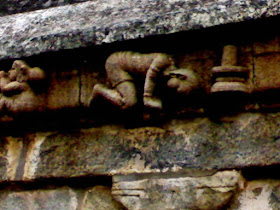The interesting part of some of these old quotes is that some of them have had a very interesting transformation, so that people are oblivious of its original meaning. Also the new meanings given to those quotes are quite relevant too! The most interesting part is that the original meaning is conveyed so elegantly, short and concise. Some of them even have a story or a legend behind them. Some of these quotes have some word transformations too that might make them more relevant and interesting.
Let us see take a look at the first one

"Aarilum Saavu, Noorilum Saavu"
the present day meaning, Death occurs even at the age of six and at the age of hundred
Aaru - Six
Saavu - Death
Nooru - One hundred
This meaning is quite acceptable and is advised to those in dejection in life and console them or bring some confidence in them. So that the affected persons will throw off their worries and get back to normalcy. Because in this world people die at the age of six and at the age of hundred, so there is no point in being dejected or disoriented. Just live the life until you can and put in your best efforts.
But the actual meaning is a way different and has a story behind it too, but there is a subtle similarity between the old and new meanings. The saying was to illustrate the position of Karnan, the greatest and the most generous person of all times. The story is that Karnan came to know that he is the son of Kunti Devi, making him the eldest of the Five Pandavas. So including him there are six Pandavas. The enemies of Pandavas - The Kauravas - were 100 in number. Karnan was in a confusion, whether to fight against the Kauravas, joining as the sixth force among the Pandavas, or to fight against his brothers joining the 100 Kauravas. Finally, the gratitude he owed to Dhuryodhana won and made him think, that even if I fight as the Six Pandavas and 100 Kauravas, the result is going to be his death. So he did not want to betray his friend Dhuryodhana who helped him get the recognition he has now. And he fought with Dhuryodhana and died as a great warrior that even Lord Krishna held him his high regards.
The next one is still interesting

"Shiva Poojayil Karadi Pugundha Maadhiri"
meaning, a bear entering when the Pooja (Worship) is being conducted for Lord Shiva. Which is, obstructive to the holy or the auspicious event happening.
Pooja - Worship
Karadi - Bear
Pugundha - Entering
Maadhiri - like
This quote is used when there is any hindrance during an auspicious or an important event is going on.
But actually the meaning of it has been misinterpreted. Karadi also means a wind instrument that resembles a circular shaped long horn. The Karadi is blown when the worship, especially the Deepa Aradhana is being performed in a Lord Shiva's Pooja. So the sound of the Karadi entering the Shiva's Pooja indicate something important happening inside the Sanctum. But later this quote got misinterpreted, with the Karadi (the bear) for Karadi (The horn).

"Kallai Kandaal Naayai Kanom
Naayai Kandaal Kallai Kanom"
meaning, when you find a stone to pelt, the dog is missing. And when you find a dog, there is no stone to pelt at it.
Kall - Stone
Kandaal - Seeing, finding
Naai - Dog
Kanom - Missing
But actually this quote refers to the statue of Lord Bhairava, a form of Shiva with the Dog has his mount. It is rather told to describe the gestalt in finding the supreme being. When you see the Lord Bhairava statue as a stone, you don't see the divine aspect in it. But if you see the divine aspect you don't see the stone in it.
The final one is

"Adi Udhavukindra Maadhiri
Annan Thambi Udhava Maatargal"
meaning, Brothers, elder and younger, won't be helpful as beating and thrashing someone helps in getting something done.
Adi - Beating, Thrashing, Chappals, Bottom most thing, Feet
Udhavi - Help
Maadhiri - like
Annan - Elder Brother
Thambi - Younger Brother
Maatargal - Negation of accepting to do things
The actual meaning is that of from Ramayana. When Lord Rama when to the forests for 14 years giving up the country and throne to his brother Bharatha. Bharatha came running meet Lord Rama and asked begged him to come back to the country and accept the throne. And Bharatha said that he will not to sit on the throne that his brother Rama deserves. Rama advised Bharatha a lot, but in vain. The people in the country were really sad that they do not have a King to rule the country. Bharatha then requested Rama for his Padhugai and told that he will run the country with the Rama's Padhugai in place of Rama in the throne, until Rama comes back from the forest after 14 years. So it means that as the Adi (Padhugai) helped to rule the country, the elder brother Rama and the younger brother Bharatha did not help the people in being the King and ruling the country.
Though these quotes have transformed in content and meaning over time, the actual message that was conveyed has to pass on too. These quotes have been passed on for generations with the literal or more straight-forwardly applicable meaning taking predominance. The actual meaning, if any, should be probed and preserved for the days to come
More to come, until then...















































